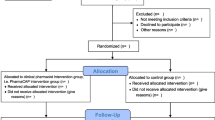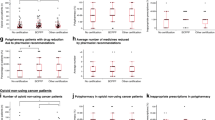Abstract
Background
Drug-related problems (DRPs) prevent patients from fully benefiting from drug treatment. Unrelieved pain in patients with cancer is still widespread. Pharmacists can play a role in closely monitoring cancer patients, pain control maintenance, and patient consultation.
Objective
To evaluate the clinical effects and changes in drug costs of pharmacists’ interventions on patients with DRPs related to cancer pain.
Setting
An academic teaching hospital in Shanghai, China.
Methods
Patients with cancer pain admitted to Shanghai Tongren Hospital from October 2018 to February 2019 were randomized into the intervention and control groups. The Pharmaceutical Care Network Europe classification V8.02 was used to categorize DRPs treated with analgesics. Patients’ pain relief, the occurrence of adverse drug reactions, and drug cost-saving through the resolution of DRPs were evaluated.
Main outcome measure
Problems and causes of drug-related problems, interventions proposed, and outcome of pharmacy recommendations.
Results
A total of 172 patients were enrolled and randomized into the intervention group (n = 86) and the control group (n = 86). The pharmacist detected 66 DRPs in 48 patients (55.8%) of the intervention group, an average of 0.8 DRPs per patient. A total of 149 interventions were proposed by the pharmacist. Compared to the control group, the drug intervention produced more pain relief on the third day of analgesic treatment. In the intervention group, a total of 33 DRP interventions resulted in cost changes, saving a drug cost of $489.90, averaging $11.94 per intervention.
Conclusion
Our study suggests that pharmacy service in patients with cancer pain can resolve drug-related problems and reduce drug costs.
Similar content being viewed by others
References
https://www.pcne.org/upload/files/230_PCNE_classification_V8-02.pdf. Accessed 23 December 2020.
Zhu Y, Liu C, Zhang Y, Shi Q, Kong Y, Wang M, et al. Identification and resolution of drug-related problems in a tertiary hospital respiratory unit in China. Int J Clin Pharm. 2019;41(6):1570–7.
Xu L. Roles and experience of clinical pharmacists in the analgesic treatment for patients with cancer pain. China Pharmacy. 2015;26(2):262–3.
National Comprehensive Cancer Network (NCCN). NCCN clinical practice guidelines in Oncology: Adult Cancer Pain (Version1.2020). https://www.nccn.org/professionals/physician_gls/pdf/pain.pdf. Accessed 23 December 2020.
Dispennette R, Hall LA, Elliott DP. Activities of palliative care and pain management clinical pharmacists. Am J Health Syst Pharm. 2015;72(12):999–1000.
O’Connor M, Hewitt LY, Tuffin PH. Community pharmacists’ attitudes toward palliative care: an Australian nationwide survey. J Palliat Med. 2013;16(12):1575–81.
Chen J, Lu XY, Wang WJ, Shen B, Ye Y, Jiang H, et al. Impact of a clinical pharmacist-led guidance team on cancer pain therapy in China: a prospective multicenter cohort study. J Pain Symptom Manage. 2014;48(4):500–9.
Hammer KJ, Segal EM, Alwan L, Li S, Patel AM, Tran M, et al. Collaborative practice model for management of pain in patients with cancer. Am J Health Syst Pharm. 2016;73(18):1434–41.
Yamada M, Matsumura C, Jimaru Y, Ueno R, Takahashi K, Yano Y. Effect of Continuous Pharmacist Interventions on Pain Control and Side Effect Management in Outpatients with Cancer Receiving Opioid Treatments. Biol Pharm Bull. 2018;41(6):858–63.
Edwards Z, Ziegler L, Craigs C, Blenkinsopp A, Bennett MI. Pharmacist educational interventions for cancer pain management: a systematic review and meta-analysis. Int J Pharm Pract. 2019;27(4):336–45.
Wang Y, Huang H, Zeng Y, Wu J, Wang R, Ren B, et al. Pharmacist-led medication education in cancer pain control: A multicentre randomized controlled study in Guangzhou. China J Int Med Res. 2013;41(5):1462–72.
Zhang Y, Wang Y, Xiao Z, Xu F. Pharmacists’ roles in cancer pain control: A model in developing China. Res Social Adm Pharm. 2015;11(3):e144–5.
Liu J, Wang C, Chen X, Luo J, Xie J, Li S, et al. Evaluation of pharmacist interventions as part of a multidisciplinary cancer pain management team in a Chinese academic medical center. J Am Pharm Assoc. 2020;60(1):76–80.
The National Health Commission. http://www.nhc.gov.cn/yzygj/s3593/201809/6725a91b9e424691b5c9e8ee6df1fad8.shtml. Accessed 23 December 2020.
Xie Z, Zhai S, Sun L, An G. The study of effects of pharmaceutical care for 43 cancer pain patients. Chin Hosp Pharm J. 2012;32(10):799–802.
Saokaew S, Maphanta S, Thangsomboon P. Impact of pharmacist’s interventions on cost of drug therapy in intensive care unit. Pharm Pract (Granada). 2009;7(2):81–7.
Umar RM, Apikoglu-Rabus S, Yumuk PF. Significance of a clinical pharmacist-led comprehensive medication management program for hospitalized oncology patients. Int J Clin Pharm. 2020;42(2):652–61.
Qu C, Meng L, Wang N, Chen Y, Yang X, Wang J, et al. Identify and categorize drug-related problems in hospitalized surgical patients in China. Int J Clin Pharm. 2019;41(1):13–7.
Lampert ML, Kraehenbuehl S, Hug BL. Drug-related problems: evaluation of a classification system in the daily practice of a Swiss University Hospital. Pharm World Sci. 2008;30(6):768–76.
Westerlund T, Marklund B. Assessment of the clinical and economic outcomes of pharmacy interventions in drug-related problems. J Clin Pharm Ther. 2009;34(3):319–21.
McMullin ST, Hennenfent JA, Ritchie DJ, Huey WY, Lonergan TP, Schaiff RA et al (1999) A prospective, randomized trial to assess the cost impact of pharmacist initiated interventions. Arch Intern Med. 1999;159(19):2306–9.
Acknowledgements
The authors would like to thank all the patients that agreed to participate in this study.
Funding
This study was supported by the Shanghai Jiaotong University School of Medicine Hospital Pharmaceutical Research Fund (JDYX2017ZD005).
Author information
Authors and Affiliations
Corresponding author
Ethics declarations
Conflict of interest
All authors declare that they have no conflict of interest.
Additional information
Publisher's Note
Springer Nature remains neutral with regard to jurisdictional claims in published maps and institutional affiliations.
Rights and permissions
About this article
Cite this article
Zhang, P., Lv, D., Zhao, J. et al. Evaluation of pharmacists’ interventions on drug-related problems and drug costs in patients with cancer pain. Int J Clin Pharm 43, 1274–1282 (2021). https://doi.org/10.1007/s11096-021-01247-w
Received:
Accepted:
Published:
Issue Date:
DOI: https://doi.org/10.1007/s11096-021-01247-w




